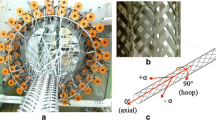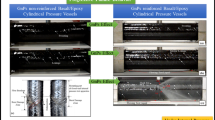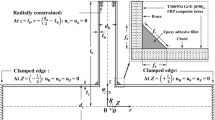Abstract
This study aims to investigate the radial gradient structural effect on energy absorption and failure behavior of braided composite tubes. Two-layer tubular braided fabrics were fabricated using over-braiding technology with three types of radial gradient configurations in terms of uninform, descending and ascending pattern. The structure of surface layer touching with indenter roll was found to have a significant role on the bending behavior and failure mode. The composite tube possessing the small angle surface layer tends to fail in top-surface mode characterized by compression damage in contact area between indenter roll and tube. With the increasing of the braiding angle in surface layer, the bottom-surface failure mode characterized by penetrating crack in circumferential direction was observed, which accompanies abruptly loading drop and loss of energy absorption capacity. In addition, the tube in descending gradient pattern contributes to higher flexural modulus and peak load due to high fiber volume fraction, while keeps top-surface failure mode because of load spreading ability provided by surface layer with small braiding angle. The results show that a proper selection of stacking sequence and braiding angle in multi-layer braided tube is capable of effectively enhancing the energy absorption of tubal structures under bending load.
Similar content being viewed by others
References
A. Baroutaji, M. Sajjia, and A. Olabi, Thin-Walled Structures, 118, 137 (2017).
Y. Kyosev, “Braiding Technology for Textiles: Principles, Design and Processes”, pp.2–11, Woodhead Publishing, 2014.
Ayranci, Cagri and J. Carey, Compos. Struct., 85, 43 (2008).
C. H. Chiu, K. H. Tsai, and W. J. Huang, J. Compos. Mater., 32, 1964 (1998).
V. M. Karbhari and J. E. Haller, Compos. Struct., 43, 93 (1998).
Z. Ping, L. Gui, and Z. Fan, Acta Materiae Compositae Sinica, 24, 146 (2007).
V. M. Karbhari, P. J. Falzon, and I. Herzberg, J. Compos. Mater., 31, 1164 (1997).
C. H. Chiu, K. H. Tsai, and W. J. Huang, Compos. Sci. Technol, 59, 1713 (1999).
C. Priem, R. Othman, P. Rozycki, and D. Guillon, Compos. Struct., 116, 814 (2014).
S. Jbeard and F. Chang, Int. J. Crashworthiness, 7, 191 (2002).
P. Zhang, L. Gui, Z. Fan, Q. Yu, and Z. Li, Comput. Mater. Sci., 73, 146 (2013).
X. Xiao, M. E. Botkin, and N. L. Johnson, Thin-Walled Structures, 47, 740 (2009).
A. Miravete, J. M. Bielsa, A. Chiminelli, J. Cuartero, S. Serrano, and N. Tolosana, Compos. Sci. Technol., 66, 2954 (2006).
J. Huang and X. Wang, Compos. Struct., 91, 222 (2009).
C. Mcgregor, N. Zobeiry, R. Vaziri, A. Poursartip, and X. Xiao, Compos. Pt. A-Appl. Sci. Manuf., 95, 208 (2017).
P. Potluri, A. Manan, M. Francke, and R. J. Day, Compos. Struct., 75, 377 (2006).
R. Sturm and F. Heieck, Compos. Struct., 134, 957 (2015).
H. Zhou, W. Zhang, T. Liu, B. Gu, and B. Sun, Compos. Part A. Appl. Sci. Manuf., 79, 52 (2015).
Z. Li, Z. Zheng, J. Yu, and L. Guo, Mater. Des., 52, 1058 (2013).
I. Duarte, M. Vesenjak, and L. Krstulović-Opara, Compos. Struct., 109, 48 (2014).
G. Sun, T. Pang, G. Zheng, J. Song, and Q. Li, Int. J. Mech. Sci., 115, 465 (2016).
Acknowledgement
The authors gratefully acknowledge the great support from the National Natural Science Foundation of China (Grant No.51775514, 11702249) and Zhejiang Provincial Natural Science Foundation of China (Grant No.LR18E050001, LGG19E050028).
Author information
Authors and Affiliations
Corresponding author
Rights and permissions
About this article
Cite this article
Wu, Z., Shen, Y., Pan, Z. et al. Three-point Bending Behavior and Energy Absorption Capacity of Composite Tube Reinforced by Gradient Braided Structure in Radial Direction. Fibers Polym 20, 1455–1466 (2019). https://doi.org/10.1007/s12221-019-1088-x
Received:
Revised:
Accepted:
Published:
Issue Date:
DOI: https://doi.org/10.1007/s12221-019-1088-x




